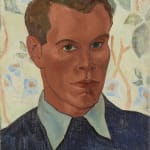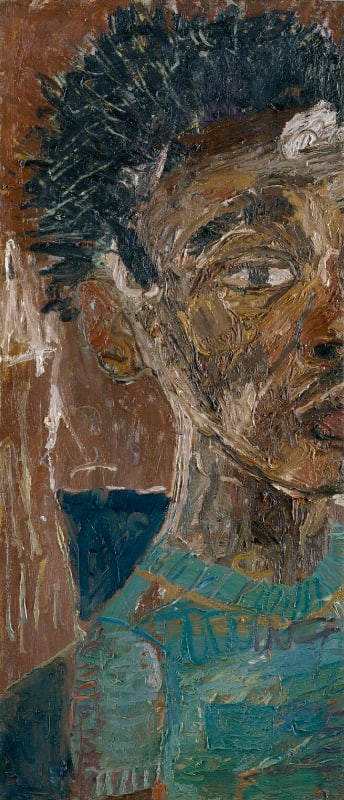Christopher Wood 1901-1930
Self Portrait, c. 1926-7
oil on canvas
16 x 12 inches
40.6 x 30.5 cm
40.6 x 30.5 cm
Further images
In 1925, a then 24-year-old Christopher Wood resolved that his paintings should aim to be less derivative of the French modern masters: ‘I am going through a very difficult period...
In 1925, a then 24-year-old Christopher Wood resolved that his paintings should aim to be less derivative of the French modern masters: ‘I am going through a very difficult period at the moment as I must decide really what I am going to do in the future. All the pictures that I paint now will be fatal, one way or another, to my career. They must be personal, quite different to everyone else’s and full of English character.’1 Wood’s renewed interest in making more personal work seems to have led to
an interest in self-portraiture and, while he made numerous self-portrait drawings from at least as early as 1924, the present work is one of only two self-portraits he is known to have painted in oil.
Wood spent the first half of 1926 in Paris, dividing the latter part of the year between London and Cornwall. On the recommendation of Picasso, Wood was commissioned to create costume and set designs for Sergei Diaghilev's ballet Romeo and Juliet. When his designs were rejected at the last minute, Wood instead concentrated on making a name for himself
in England, becoming a member of both the London Group (1926) and the Seven and Five Society (1926 – 30). Former Kettle’s Yard curator Hilary Gresty notes that Wood’s ‘career began to take shape in 1926’ and that, ‘by the end of the year, his painting was beginning to assume individuality.’ 2
Wood’s other, almost life-size self-portrait from 1927, was acquired from the artist’s estate by the collector Jim Ede in 1930 and is part of the collection of the Kettle’s Yard, Cambridge. Buoyed by the recent endorsement of Picasso, Wood exudes an easy confidence in both works, presenting himself as a handsome and successful young man. The paintings therefore act as a kind of self-promotion, despite being painted at a time when the artist was only just beginning to establish a personal style and reputation. While art historian Katy Norris has described the larger self-portrait as Wood’s ‘strongest affirmation of his personal
identification with Picasso’, there are a number of artists whose influences are felt in this smaller self-portrait. The large decorative flowers in the background of the picture recall the backdrops of Matisse’s Odalisque with Red Trousers, c.1924 – 25 and Gauguin’s Self-Portrait with Portrait of Émile Bernard (Les misérables), 1888. Wood also seems to pay direct homage here to Van Gogh’s Self-Portrait, 1889, the figure with whom he most strongly identified, having read Van Gogh’s collected letters while travelling through Europe some years before. Like Van Gogh, Wood was partly self-taught and, more forebodingly, Wood endured similar psychological torment that ultimately led to his suicide aged 29.
1 Richard Ingleby, Christopher Wood: An English Painter, Allison & Busby, London, 1st edition, 1995, p109
2 Hilary Gresty, Christopher Wood: The Last Years 1928 – 1930, Newlyn Art Gallery, Penzance, 1989, exh cat, p7
an interest in self-portraiture and, while he made numerous self-portrait drawings from at least as early as 1924, the present work is one of only two self-portraits he is known to have painted in oil.
Wood spent the first half of 1926 in Paris, dividing the latter part of the year between London and Cornwall. On the recommendation of Picasso, Wood was commissioned to create costume and set designs for Sergei Diaghilev's ballet Romeo and Juliet. When his designs were rejected at the last minute, Wood instead concentrated on making a name for himself
in England, becoming a member of both the London Group (1926) and the Seven and Five Society (1926 – 30). Former Kettle’s Yard curator Hilary Gresty notes that Wood’s ‘career began to take shape in 1926’ and that, ‘by the end of the year, his painting was beginning to assume individuality.’ 2
Wood’s other, almost life-size self-portrait from 1927, was acquired from the artist’s estate by the collector Jim Ede in 1930 and is part of the collection of the Kettle’s Yard, Cambridge. Buoyed by the recent endorsement of Picasso, Wood exudes an easy confidence in both works, presenting himself as a handsome and successful young man. The paintings therefore act as a kind of self-promotion, despite being painted at a time when the artist was only just beginning to establish a personal style and reputation. While art historian Katy Norris has described the larger self-portrait as Wood’s ‘strongest affirmation of his personal
identification with Picasso’, there are a number of artists whose influences are felt in this smaller self-portrait. The large decorative flowers in the background of the picture recall the backdrops of Matisse’s Odalisque with Red Trousers, c.1924 – 25 and Gauguin’s Self-Portrait with Portrait of Émile Bernard (Les misérables), 1888. Wood also seems to pay direct homage here to Van Gogh’s Self-Portrait, 1889, the figure with whom he most strongly identified, having read Van Gogh’s collected letters while travelling through Europe some years before. Like Van Gogh, Wood was partly self-taught and, more forebodingly, Wood endured similar psychological torment that ultimately led to his suicide aged 29.
1 Richard Ingleby, Christopher Wood: An English Painter, Allison & Busby, London, 1st edition, 1995, p109
2 Hilary Gresty, Christopher Wood: The Last Years 1928 – 1930, Newlyn Art Gallery, Penzance, 1989, exh cat, p7
Provenance
Lucy Wertheim, London (probably)
The Redfern Gallery, London
Private Collection, UK, acquired in September 1954
Private Collection, UK, acquired in 1991
Exhibitions
London, The Redfern Gallery, Christopher Wood, Paul Feiler, 3 September – 2 October 1954, cat no.59, not illus, either the present work, or the Kettle’s Yard self-portrait exhibited
1
of
12
Related artworks








